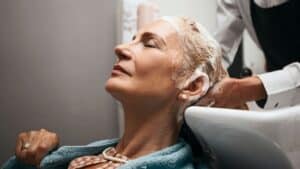
In my mid-20s, I yanked out my first silver hair with terror in my eyes. That sent a signal to the rest of the white follicles waiting in my scalp to immediately sprout and cover my head as if fertilized by God’s very own growth hormone.
By the time I hit 27, I was coloring my hair every two and a half weeks, as my hair grows about an inch a month. Just imagine the hair-covered character Cousin Itt from the television show, The Addams Family, with a bottle of dark brown hair color in hand and red lipstick and you have a replica of me.
This has led me to experiment with all sorts of color treatments, highlights, shades, and random styles that still make me laugh. Plus, at one point I lived in London for four years where I tried to mimic crazy street styles with enormous gusto.
I’ve colored my hair green, purple, red (bright neon red, mind you, not the soft luxurious red mane of Julianne Moore), blonde, and every nuance of copper, brown, mahogany, et al.
Having said all of that, I feel I am in a good position to advise on what to do with over-dry and processed hair, even if you’ve decided to allow your hair to return to its natural shade. (I will stop the madness and go silver at some point; I promise). Here are my top five recommendations to heal your hair.
Stop Using Shampoo
After reading that headline, I’m guessing that about 90% of you spit-up. When I mentioned this to my life-long best friend, she treated me like I had just eaten worms.
Shampoo is drying, and by washing with conditioner instead of shampoo, you will notice an immediate difference. In fact, go without washing as long as you can without looking like a vagabond, then rinse with conditioner focusing on the damaged ends of the hair.
If you have silver hair, try purple conditioner like Clairol Shimmer Lights Conditioner Blonde and Silver. It is very purple, so be sure to switch it out now and then with a non-color enhanced conditioner. This is not to say you should never use shampoo, which leads us to our second point.
Grease, Then Shampoo
Yes, I used the word grease, and no, that isn’t a typo. Before you shampoo your hair, load it up with argan, coconut, or any type of oil, and let it sit on your hair for at least 15 minutes before shampooing.
One time I stuck my head in the sink and coated it with cold-pressed virgin olive oil like I was a chicken, and then wrapped my head in cellophane. My dog, Mr. Tito, thinking I was dinner, tried to lick my head. After I shampooed, though, my hair became a lovely silky texture I hadn’t seen in years. Go olive oil!
A word on shampoo: avoid any product that uses the word clarifying, which translates to dry AF. Instead, buy shampoos that use words like sulfate-free, color protector, oil enriched, etc.
Get a Protein Treatment
One of my favorite discoveries in life is inexpensive ways to achieve excellent results.
Protein hair treatments do not fall into this category. If your hair is severely damaged, cough up the cash and have a professional do it. I have spent more money than I care to recall on dead-beat products that do very little. Trust me, visit the hairdresser.
Protect Your Hair When Using Heat
There’s nothing that damages your hair more than using the heat of hair dryers, curling irons, or flat irons. For goodness sake, apply a heat-activated treatment to damp hair before styling to protect your locks. My personal favorite is Bumble and Bumble Hairdressers Invisible Oil Primer. Your hair will thank you.
Vitamins Don’t Work Past a Certain Point
If you have read any of my past articles, you know that I am a gargantuan advocate of using a naturopathic practices and supplements to achieve wellness. When it comes to damaged hair, this is not the case.
Once your hair leaves your scalp, it is dead, and all the vitamins in the world will not help it recover.
Taking the right supplements can help your hair grow, thicken, become shinier, and look a ton better. But the damaged ends need to either be hacked off or treated with the love of the above points.
Personally speaking, I have my damaged ends trimmed at least once a month to keep my hair looking lively and less like Cousin Itt.
After you use the olive oil on your head and on the roast chicken dinner, I’d love to hear what happened. Besides the people you live with wondering if you’ve had too much booze, it might lead to hair that moves and radiates the stunning glow of pre-treatment days. That and a tasty meal.
Let’s Have a Conversation:
When did your hair start turning silver? What did you do about it? How do you feel about your hair now that you’re over 60? What hair treatments have you tried to date? Which ones worked best? Please share so we can all benefit from your experience!





